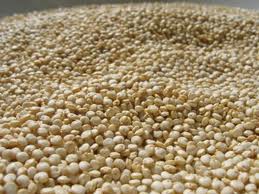Quinoa is one of my favorites! Many people have never heard of it nor know how to pronounce (I didn’t either about 2 years ago)! It is pronounced keen-wa.
What is quinoa?
While quinoa is usually considered to be a whole grain, it is actually a seed, but can be prepared like whole grains such as rice or barley. Quinoa is my favorite whole grain for three reasons: First, it takes less time to cook than other whole grains – just 10 to 15 minutes. Second, quinoa tastes great on its own, unlike other grains such as millet or teff. Add a bit of olive oil, sea salt and lemon juice and – yum OR vegetable broth! Finally, of all the whole grains, quinoa has the highest protein content, so it’s perfect for vegetarians and vegans. Quinoa provides all 9 essential amino acids, making it a complete protein. Quinoa is a gluten-free and cholesterol-free whole grain, is kosher for Passover, and is almost always organic.
Culinary ethnologists will be interested to know that quinoa was a staple food for thousands of years in the Andes region of South America as one of just a few crops the ancient Incas cultivated at such high altitude. Who would not want to reap the benefits of this amazing superfood?
1. Quinoa is one of the most protein-rich foods we can eat. It is a complete protein containing all nine essential amino acids. (already stated above)
2. Quinoa contains almost twice as much fiber as most other grains. Fiber is most widely known to relieve constipation. It also helps to prevent heart disease by reducing high blood pressure and diabetes. Fiber lowers cholesterol and glucose levels, may lower your risk of developing hemorrhoids and may help you to lose weight as it takes a longer time to chew than does other foods because it makes you feel fuller for longer and is less “energy dense” which means it has fewer calories for the same volume of food.
3. Quinoa contains Iron. Iron helps keep our red blood cells healthy and is the basis of hemoglobin formation. Iron carries oxygen from one cell to another and supplies oxygen to our muscles to aid in their contraction. Iron also increases brain function because the brain takes in about 20% of our blood oxygen. There are many benefits of iron some more of which include neurotransmitter synthesis, regulation of body temperature, aids enzyme activity and energy metabolism.
4. Quinoa contains lysine. Lysine is mainly essential for tissue growth and repair.
5. Quinoa is rich in magnesium. Magnesium helps to relax blood vessels and thereby to alleviate migraines. Magnesium also may reduce Type 2 diabetes by promoting healthy blood sugar control. Other health benefits of magnesium include transmission of nerve impulses, body temperature regulation,detoxification, energy production, and the formation of healthy bones and teeth.
6. Quinoa is high in Riboflavin (B2). B2 improves energy metabolism within brain and muscle cells and is known to help create proper energy production in cells.
7. Quinoa has a high content of manganese. Manganese is an antioxidant, which helps to prevent damage of mitochondria during energy production as well as to protect red blood cells and other cells from injury by free radicals.
All of these amazing benefits in one little grain??? I love quinoa as a side dish or even the main dish mixed with vegetables! But put this little amazing grain in with 69 other AMAZING superfoods, nutrients, and vitamins and you get
SHAKEOLOGY! Shakeology has given many energy, fights diseases, and fights food cravings.
[button link=”myshakeology.com/nikkikminton” type=”big” color=”green”] ORDER NOW[/button]
Comments
comments





